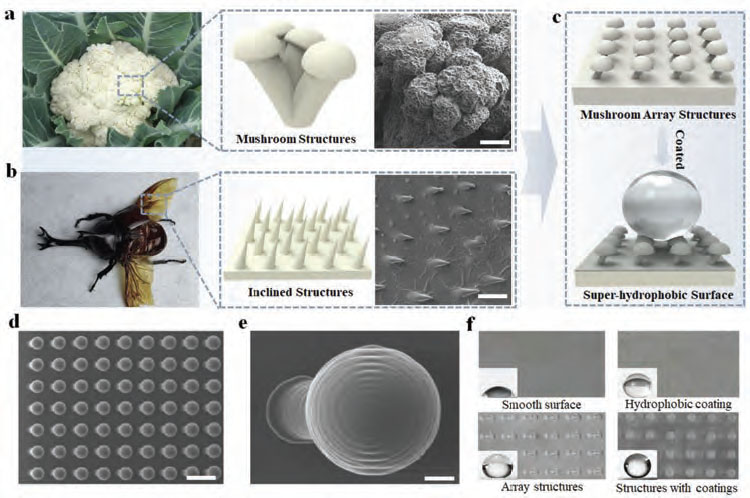| Sep 25, 2023 | |
Bionic functional surface achieves programmable and patterned droplet bouncing (w/video) |
|
| (Nanowerk Spotlight) Scientists are finding creative ways to leverage the phenomenon of water droplets bouncing off surfaces for functional applications like self-cleaning technology and energy harvesting. The key lies in engineering surfaces that can actively control droplet behavior. | |
| Recently, researchers in China developed a new method to precisely direct the bouncing patterns of water droplets using customizable mushroom-shaped microstructures. Their work, published in Advanced Functional Materials ("Programmable Droplet Bouncing on Bionic Functional Surfaces for Continuous Electricity Generation"), demonstrates how purposeful surface design can manipulate droplets for useful ends. | |
| For years, scientists have looked to nature for inspiration on water-repellant surfaces, studying biological examples like lotus leaves and insect wings. These natural surfaces contain microscopic architectural features that trap air underneath droplets. Preventing full wetting gives the droplets more mobility, enabling them to freely roll or bounce off the surface. However, natural surface traits are fixed, limiting control over droplet movements. | |
| This new research demonstrates how artificially engineered surfaces with tunable designs can actively direct bouncing droplets along programmed trajectories. It provides a compelling proof-of-concept for how customizable surface microstructures could enable emerging water management applications. | |
 |
|
| Bionic functional surfaces with inclined micromushrooms. a) The cauliflowers covered with numerous micromushrooms. b) The wings of a cicada covered with inclined microstructures. c) Inclined mushrooms array with a hydrophobic layer. d) A printed functional surface with regularly arranged micromushrooms, the scale bar is 500 µm. e) SEM image of a single printed micromushroom, the scale bar is 20 µm. f)Wettability of a smooth flat surface, a flat surface coated with a hydrophobic layer, a structured surface with micromushrooms and a structured surface with micromushrooms coated with a hydrophobic layer. (Reprinted with permission by Wiley-VCH Verlag) | |
| Manipulating droplets requires controlling dynamic processes like speed, direction and bouncing patterns. Natural superhydrophobic surfaces can make droplets bead up and bounce off, but they lack precision. | |
| The key to programming droplet bouncing lies in the surface structures. The researchers drew inspiration from nature, noting water-repellant surfaces on plants like lotus leaves and insect wings like cicadas. These biological surfaces are patterned with microscopic bumps or hairs that trap air underneath, preventing water from fully wetting the surface. Building on this concept, the team used high-resolution 3D printing to create plastic surfaces covered in tiny, mushroom-shaped pillars. A hydrophobic spray coating helped further repel water. | |
| Unlike natural examples, the researchers could carefully tune the shape, size, orientation and arrangement of the mushroom microstructures. Altering these surface features allowed precise control over the bouncing water droplets, directing their speed and trajectory. | |
| Droplets followed the tilt angle of the mushrooms, springing off at an equivalent angle. The best horizontal bouncing distance of 2.5 mm occurred with mushrooms tilted 50 degrees. Meanwhile, vertical bouncing height peaked at 7.1mm with 90-degree perpendicular mushrooms. Besides direction, the mushroom head size also impacted bouncing velocity, with 100 micrometer diameter heads optimizing droplet jump height and distance. | |
| Importantly, the surfaces could be patterned to orchestrate complex droplet paths. The team demonstrated this with surfaces containing mushroom patches oriented in repeating pentagon and hexagon shapes. Water droplets bounced from patch to patch, tracing out the preset shape. In another demo, outward-tilting mushrooms caused droplets to bounce away from the surface center, showcasing self-cleaning potential. | |
| According to the researchers, these intelligently designed surfaces could enable new water management applications. Patterned bouncing surfaces might transport collected water to a storage site. The ability to repel droplets could prevent buildup of dirt or ice on solar panels and aircraft. There is even potential to convert the energy of impacting raindrops into usable electricity. | |
| To demonstrate, the team connected their mushroom-coated surface to an electronic circuit. Water droplets falling on the surface generated a small electrical charge. Though not enough for direct use, the proof-of-concept shows the possibility of harvesting clean power from rain. The self-cleaning ability is also important here, ensuring continuous power generation. | |
| More broadly, the research highlights how purposeful design of surfaces on the smallest scale can enable macro-level functionality. Just like nature’s lotus leaves, wings and petals, engineers can create surfaces with responsive behaviors by patterning microscopic structural features. The complex yet predictable bouncing of droplets here provides a compelling example. | |
| Looking forward, the customizable mushroom surface could see applications beyond water manipulation. Similar principles may allow smart redirection of microparticles, droplets of chemical reagents, or even living cells for analysis and sorting. With further development, clever surface architectures like these mushroom structures will open new possibilities across many fields. | |
 By
Michael
Berger
– Michael is author of three books by the Royal Society of Chemistry:
Nano-Society: Pushing the Boundaries of Technology,
Nanotechnology: The Future is Tiny, and
Nanoengineering: The Skills and Tools Making Technology Invisible
Copyright ©
Nanowerk LLC
By
Michael
Berger
– Michael is author of three books by the Royal Society of Chemistry:
Nano-Society: Pushing the Boundaries of Technology,
Nanotechnology: The Future is Tiny, and
Nanoengineering: The Skills and Tools Making Technology Invisible
Copyright ©
Nanowerk LLC
|
|
|
Become a Spotlight guest author! Join our large and growing group of guest contributors. Have you just published a scientific paper or have other exciting developments to share with the nanotechnology community? Here is how to publish on nanowerk.com. |
|
